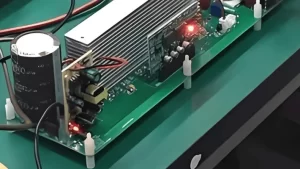Understanding High-Frequency Inverter Working Principles
High-frequency inverters are essential components in modern power electronics, widely used in applications such as solar power systems, uninterruptible power supplies (UPS), and electric vehicles. These devices efficiently convert direct current (DC) into alternating current (AC) at high frequencies, offering advantages like compact size, improved efficiency, and reduced weight. In this article, we will explore the working principles of high-frequency inverters, breaking down their operation, key components, and benefits.
What Is a High Frequency Inverter?
A high-frequency inverter is a type of power inverter that operates at switching frequencies typically above 20 kHz, far exceeding the standard 50/60 Hz frequency of traditional inverters. By utilizing high-frequency switching, these inverters can employ smaller transformers and filtering components, making them ideal for space-constrained applications. The core principle involves rapidly switching DC input on and off to generate an AC waveform through pulse-width modulation (PWM) techniques.
Key Components of a High Frequency Inverter
To understand how a high-frequency inverter works, it is important to familiarize yourself with its main components:
- DC Input Source: Provides the direct current, which can come from batteries, solar panels, or other DC power supplies.
- Switching Devices: Typically MOSFETs or IGBTs that switch the DC input on and off at high frequencies.
- High-Frequency Transformer: Steps up or down the voltage as needed while providing electrical isolation.
- Control Circuit: Uses microcontrollers or dedicated ICs to generate PWM signals for precise switching.
- Output Filter: Smooths the high-frequency AC output into a clean sine wave or modified sine wave, depending on the design.
How High Frequency Inverters Work
The operation of a high-frequency inverter can be broken down into several stages:
Step 1: DC Input and Switching
The process begins with a stable DC input. The switching devices, controlled by PWM signals from the control circuit, rapidly turn the DC supply on and off. This creates a series of high-frequency pulses rather than a continuous flow.
Step 2: High-Frequency Transformation
These pulses are fed into a high-frequency transformer. Unlike low-frequency transformers, which are bulky, high-frequency transformers are compact due to the increased operating frequency. The transformer adjusts the voltage level as required—stepping it up for higher AC output or down for lower output.
Step 3: Rectification and Filtering (If Needed)
In some designs, the transformed AC may undergo rectification back to DC for intermediate processing, but in most high-frequency inverters, the output is directly filtered. The output filter, consisting of inductors and capacitors, removes high-frequency noise and harmonics, resulting in a stable AC waveform.
Step 4: AC Output
The final output is a clean AC signal, which can be a pure sine wave or a modified sine wave, suitable for powering various AC loads.
Advantages of High-Frequency Inverters
High-frequency inverters offer several benefits over their low-frequency counterparts:
- Compact Size and Lightweight: The use of high-frequency components allows for significantly smaller transformers and filters.
- Higher Efficiency: Reduced core losses in transformers and lower switching losses contribute to better overall efficiency.
- Improved Performance: Faster response times and better voltage regulation make them suitable for sensitive electronic devices.
- Cost-Effectiveness: Despite complex control circuitry, the savings in material costs often make high-frequency inverters more economical.
Applications of High-Frequency Inverters
Thanks to their efficiency and compact design, high-frequency inverters are used in a variety of fields:
- Renewable energy systems, such as solar inverters
- Uninterruptible power supplies (UPS) for computers and servers
- Automotive applications, including electric vehicle powertrains
- Portable electronic devices and mobile power solutions
Conclusion
High-frequency inverters play a crucial role in modern power conversion by efficiently transforming DC to AC at elevated switching frequencies. Their working principle relies on rapid switching, high-frequency transformation, and precise filtering to deliver reliable and compact power solutions. Understanding how these inverters operate not only highlights their technical advantages but also underscores their importance in advancing renewable energy, consumer electronics, and industrial applications. As technology continues to evolve, high-frequency inverters will likely become even more efficient and integral to our daily power needs.
Table of Contents
